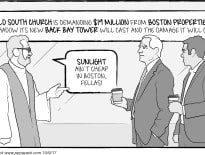As credit unions, large banks and community banks plunge deeper into the Small Business Administration loan market, the competition may drive financial institutions to offer better rates and loan terms to consumers, issue more SBA 504 loans and spur innovation.
“We want to make as many SBA loans as possible,” said William Mullin, senior vice president of commercial lending at Worker’s Credit Union, which already regularly issues loans backed by the SBA.
Late last year, Santander, another strong originator of SBA-backed loans in Massachusetts, hired Seth Goodall, former regional administrator for SBA New England, to lead the bank’s SBA division as it looks to bulk up SBA lending. And Eastern Bank, the top originator of SBA-backed loans in Massachusetts, has managed to increase its loan volume for the last three federal fiscal years.
“We are continuing to see a lot of interest from a wide array of lenders,” Robert Nelson, director of the SBA’s Massachusetts District Office, told Banker & Tradesman. “There is a lot of money chasing good borrowers.”
Massachusetts added more than 32,000 small businesses between 2010 and 2014, according to the most recent data available from the SBA.
Loan volume in the state in 2016 and 2017 is the highest in a decade. In federal fiscal year 2016, there were 2,836 SBA loans issued, collectively worth over $559 million. Although not as high, FFY 2017 had another strong showing with 2,813 SBA loans issued at a total value over $490 million.
“I think we have a good market right now,” said Paula Camara, interim director of the Massachusetts Small Business Development Center Network at Clark University. “Companies are growing and people are positioning themselves to purchase equipment with the intention to hire. They are cautious – nobody likes debt – but everyone knows that to grow, they may need that line of credit or some other form of financing.”
More lenders going after borrowers may result in more attractive interest rates and loan terms, as well as reduced fees associated with SBA-backed loans.
“Generally, more competition leads to a better environment for the small business community,” said Charles Smith, senior vice president and SBA specialist at Eastern Bank, which issued more than $73 million worth SBA loans in FFY 2017. “Some of this stuff is already happening.”
On SBA 7A loans, Smith said borrowers are receiving longer amortization periods and in some cases, can put less money down. He has seen five-year loan terms pushed out to seven or 10 years, and financial institutions easing up on down payment requirements.
Nelson added that increased competition may take some of the fees off consumers’ backs. For a 7A loan over $150,000, the lenders must pay the SBA anywhere from a 3 percent to 3.75 percent guaranty fee, which helps them operate loan programs at zero subsidy cost to the taxpayer.
These fees, however, are typically passed on to the borrowers.
While the SBA will guaranty loans at 75 percent, financial institutions can offer SBA-backed loans with a smaller SBA guaranty, said Nelson, thus resuming more of the responsibility. Because the amount guaranteed by the SBA is part of the calculation in determining the fee, the smaller the SBA guarantee, the smaller the fee on the loan, he said.
Smith also said he is seeing more attractive term rates on SBA 504 loans, despite the fact that they are much less common than 7A loans.
SBA 504 loans provide growing businesses with long-term, fixed-rate financing for major fixed assets, such as land and buildings. A 504 loan only requires a borrower to put 10 percent down for a loan.
The rest is financed through two loans – one from a certified development corporation covering up to 40 percent of the total cost, which is 100 percent guaranteed by the SBA, and one from a private financial institution covering up to 50 percent of the cost.
According to Smith, the loan from the CDC tends to come with a generous 20- or 25-year fixed rate. Although they may not have as low of an interest rate, financial institutions are starting to offer these same terms on their 504 loans, he said.
504 Loan Growth
More players in the SBA market may also lead to more 504 loans, which are not nearly as popular as the 7A program.
According to Matt Collins, vice president in the Massachusetts division of Granite State Development Corporation, a CDC that issues 504 loans, roughly 58,000 7A loans were issued in the U.S. last year, compared to just 6,000 504 loans.
“We can’t do a 504 [loan] without a partner,” he said, adding that he is astonished at how few 504 loans are issued each year. More people interested in lending with a 504 product is music to my ears.”
One of those interested in getting more involved with 504 loans is Goodall of Santander. He said he sees growth potential at both sides of the spectrum from small $100,000 loans to the $5 million maximum loans, and that the bank would definitely focus on both 7A and 504 products.
In the SBA market, traditional financial institutions are not just competing against each other; they are also competing against online lenders, who are speeding up the turnaround times for all loan applications.
Eastern Bank has already responded, launching Numerated Growth Technologies in May, a portal for loan applications, specifically for small businesses seeking loans under $100,000.
Smith said the portal has already issued around 500 SBA loans, while also speeding up the turnover time. He said Eastern customers can get loans approved as quickly as 10 or 15 minutes, while non-Eastern customers can still get an answer in a few days.
The process for applying for a loan is significantly quicker because the consumer is only answering the questions pertinent to them, as opposed to having to read through all the forms.
“Small business owners don’t have a lot of time,” said Smith. “This is definitely a response to online lenders and a response to the biggest gap in the industry.”




 |
| 


